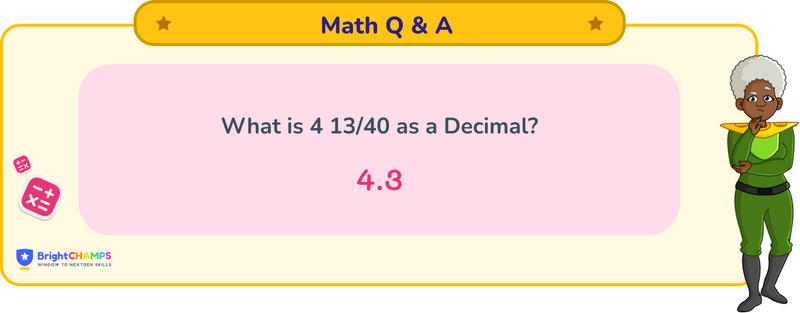Summarize this article:
 210 Learners
210 LearnersLast updated on 5 August 2025
4 13/40 as a Decimal

It is a simple question on decimal conversion. Firstly, we have to learn fractions, mixed numbers, and decimals. A fraction represents a part of a whole. It has two parts: the numerator (number on the top) here, 13, represents how many parts out of the whole. The denominator (number below) shows how many parts make the whole; here, it is 40. A mixed number has a whole part and a fractional part. A decimal is a way to represent a number that is not whole, using a decimal point (.) to separate the whole part from the fraction part. The numbers to the left of the decimal point represent the whole, and those to the right represent the fractional part.

What is 4 13/40 as a decimal?

Answer
4 13/40 as a decimal can be written as 4.325.
Explanation
To convert 4 13/40 into a decimal, we first convert the fractional part 13/40 into a decimal. Then we add this decimal to the whole number 4. Let’s see the step-by-step breakdown of the process:
Step 1: Identify the fractional part 13/40. We'll convert this fraction into a decimal using division.
Step 2: Divide the numerator (13) by the denominator (40).
Step 3: 13 divided by 40 gives 0.325.
Step 4: Combine this decimal with the whole number 4. So, 4 + 0.325 = 4.325.
The answer for 4 13/40 as a decimal is 4.325.

Important Glossaries for 4 13/40 as a decimal
- Fraction: A numerical quantity that is not a whole number, representing a part of a whole.
- Decimal: A number that uses the base ten and includes a decimal point to separate the whole part from the fractional part.
- Numerator: The top part of a fraction, indicating how many parts of the whole are being considered.
- Denominator: The bottom part of a fraction, showing how many parts make up a whole.
- Mixed Number: A number consisting of an integer and a proper fraction.

Explore More math-questions
![Important Math Links Icon]() Previous to 4 13/40 as a Decimal
Previous to 4 13/40 as a Decimal
![Important Math Links Icon]() Next to 4 13/40 as a Decimal
Next to 4 13/40 as a Decimal





